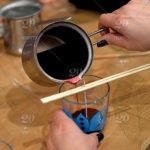Are you interested in making your own candles but frustrated with the common issue of dips forming in the wax? Learning how to prevent dips when making your own candles is an essential part of mastering the craft. From choosing the right wax to understanding temperature control, there are many factors to consider in achieving a smooth and even finish for your homemade candles.
Candle making is a creative and rewarding hobby that involves a variety of materials and processes. In this article, we will explore the basics of candle making, as well as provide tips and recommendations for preventing dips in your candles. Understanding the science behind dipping, choosing the right wax, incorporating scents properly, controlling temperature, mastering pouring techniques, selecting the correct wick, and troubleshooting common dipping issues are all crucial aspects that we will delve into.
Dipping in homemade candles can be frustrating, but with the proper knowledge and techniques, it can be easily prevented. By familiarizing yourself with the key components and methods involved in candle making, you can achieve professional-looking results right from the comfort of your own home. Whether you’re a beginner or looking to improve your skills, this article will provide valuable insights into preventing dips when making your own candles.
Understanding the Science Behind Dipping
When making your own candles, it’s essential to understand the science behind dipping in order to prevent any potential issues during the process. There are several factors that can contribute to candles dipping, such as the type of wax used, pouring technique, temperature control, and wick selection. By gaining a deeper understanding of these factors, you can effectively prevent dips and create high-quality candles.
The Role of Wax Type
The type of wax used in candle making plays a crucial role in preventing dips. It’s important to choose a wax that is specifically designed for creating candles and has a higher melting point. Soy wax and beeswax are popular options known for their ability to resist dipping. Be sure to carefully read the description and specifications of different waxes before making a selection for your candle making project.
Temperature Control
Proper temperature control is vital in preventing dips when making your own candles. If the wax is too hot when poured into the container, it can result in uneven cooling and lead to dipping.
On the other hand, if the wax is not hot enough, it may solidify with air pockets or sink in the middle after cooling. Using a reliable thermometer to monitor the temperature during each stage of the candle-making process can help ensure that the wax is at an optimal temperature for pouring and setting.
Wick Selection and Placement
In addition to choosing the right wax and controlling the temperature, selecting the correct wick for your candle is also important in preventing dips. The size and type of wick will impact how evenly the candle burns, which directly affects its overall stability and appearance.
It’s crucial to follow guidelines for wick size based on the diameter of your container or mold. Additionally, ensuring that your wick is properly centered within the container will help promote even burning and prevent dipping.
Choosing the Right Wax
When it comes to candle making, choosing the right wax is crucial in preventing dips and ensuring a smooth, even burn. There are several types of wax available, each with its own unique properties and melting points. Understanding the characteristics of different waxes will help you select the best one for your candle making project.
Types of Wax
There are various types of wax commonly used for candle making, including paraffin wax, soy wax, beeswax, and palm wax. Each type has its own set of advantages and disadvantages when it comes to preventing dips.
Paraffin wax, for example, is known for its excellent scent throw and smooth appearance but may require additional additives to prevent dipping. Soy wax is a popular choice for its natural composition and clean-burning properties, but it may be prone to frosting if not properly cooled.
Considerations for Preventing Dips
When selecting the right wax to prevent dips in your homemade candles, it’s essential to consider factors such as the type of fragrance oils or essential oils you plan to use, the desired burning time of the candle, and any potential environmental considerations. Additionally, look for waxes specifically formulated to resist cracking or shrinking during cooling to ensure a professional-looking finished product.
Tips for Selecting the Best Wax
To prevent dips when making your own candles, consider using a high-quality container blend that is designed to minimize issues such as sinkholes or uneven surfaces. Look for waxes that are specifically labeled as “no dip” or “self-leveling” to ensure a smooth finish without any imperfections.
It’s also important to follow manufacturer guidelines for melting and pouring temperatures to achieve the best results with your chosen wax. By carefully considering these factors and selecting the appropriate wax for your needs, you can effectively prevent dips in your homemade candles and create beautiful, long-lasting products.
Essential Oils and Fragrances
When making your own candles, incorporating scents like essential oils and fragrances can add a delightful aroma to your creation. However, it’s important to do so in a way that doesn’t compromise the integrity of the candle. Here are some tips on how to properly incorporate scents without causing dips in your candles:
- Choose high-quality scents: Using high-quality essential oils and fragrances can help prevent dips in your candles. Lower quality scents may contain additional ingredients that could affect the candle’s composition.
- Measure carefully: It’s crucial to measure the amount of scent you’re adding accurately. Too much oil can make the wax too soft, leading to dips, while too little may result in a lack of fragrance.
- Consider the type of wax: Different waxes can handle scents differently. Be sure to choose a wax that is compatible with the type and amount of scent you want to use.
By following these tips, you can ensure that your candles have a beautiful, long-lasting fragrance without compromising their structure.
In addition to using high-quality scents and measuring carefully, it’s also important to consider the temperature at which you add them to the wax. Adding scents at too high of a temperature can cause them to evaporate quickly, resulting in a weaker fragrance in the finished candle. On the other hand, adding them at too low of a temperature may cause them not to disperse evenly throughout the wax.
To prevent this from happening, it’s best to add scents when the wax has cooled slightly but is still liquid enough to mix thoroughly. This will allow for an even distribution of fragrance without affecting the composition of the candle.
The Importance of Proper Temperature Control
When it comes to making your own candles, proper temperature control is key to preventing dips in the finished product. The temperature at which the wax is melted, mixed, and poured can greatly impact the final result of your homemade candles.
One important factor to consider is the melting point of the wax you are using. Different waxes have different melting points, and it’s crucial to heat the wax to the appropriate temperature based on the type of wax being used. For example, soy wax has a lower melting point than paraffin wax, so it requires less heat to melt evenly.
In addition to the melting point of the wax, the ambient temperature of the room where you are making your candles can also affect the dipping process. If it’s too hot or too cold in the room, it can cause inconsistencies in the cooling process of the candle, leading to unwanted dips. It’s important to work in a controlled environment with a stable temperature to ensure smooth and even candles.
| Temperature Control Factor | Impact on Candle Making |
|---|---|
| Melting Point of Wax | Determines appropriate heating temperature for each type of wax |
| Ambient Room Temperature | Affects cooling process and can cause dips if not controlled |
Mastering the Pouring Technique
When it comes to making your own candles, mastering the pouring technique is essential in preventing dips. Here’s a step-by-step guide on how to pour the wax properly to achieve a smooth and even finish:
- Prepare your workspace: Before you begin pouring the wax, ensure that your workspace is clean and free from any potential obstructions. This will help prevent any accidents or spills during the pouring process.
- Heat the wax to the correct temperature: It’s important to heat the wax to the recommended temperature as specified by the manufacturer. Overheating or underheating the wax can lead to dipping issues, so make sure to use a thermometer to monitor the temperature accurately.
- Pour slowly and steadily: When it’s time to pour the wax into your candle mold, do so slowly and steadily. Avoid pouring too quickly, as this can create air bubbles and uneven surfaces. A controlled pour will help ensure that the wax settles evenly without creating dips.
- Avoid disturbances: Once you’ve poured the wax, refrain from moving or disturbing the candle mold. Any sudden movements can disrupt the settling process and lead to dips in your finished candle.
Mastering the pouring technique is crucial for achieving professional-looking candles without any unwanted dips. By following these steps, you can prevent dipping issues and create high-quality candles that burn evenly and beautifully.
Using the Right Wick
When it comes to making your own candles, selecting the right wick is crucial for ensuring a smooth and even burn. The wick not only determines how efficiently the candle burns, but it also affects the overall quality of the finished product. To prevent dips when making your own candles, it’s important to understand how to choose the correct wick for your specific wax and container.
The first step in selecting the right wick is considering the diameter of your candle. A general rule of thumb is that larger diameter candles require thicker wicks, while smaller diameter candles need thinner wicks. Using a wick that is too small for a large candle can result in uneven burning and tunneling, while using a wick that is too large for a small candle can cause excessive dripping and smoking.
Another important factor to consider is the type of wax you are using. Different waxes have different melting points and burn characteristics, so it’s essential to match the wick with the specific type of wax you are using. For example, soy wax typically requires a different type of wick than paraffin wax due to their varying compositions and melting points.
Lastly, consider the container in which your candle will be housed. The size and material of the container can impact how the candle burns, so it’s important to choose a wick that is appropriate for the specific container you plan to use.
| Wick Type | Candle Diameter |
|---|---|
| Small/Thin Wick | 1-2 inches |
| Medium Wick | 2-3 inches |
| Large/Thick Wick | 3+ inches |
Troubleshooting Common Dipping Issues
In conclusion, making your own candles can be a rewarding and enjoyable hobby, but it’s important to understand the potential issues that may arise during the process. By familiarizing yourself with the basics of candle making and understanding the science behind dipping, you can take proactive steps to prevent dips in your candles. Choosing the right wax, properly incorporating scents, maintaining proper temperature control, mastering pouring techniques, and using the correct wick are all crucial factors in preventing dips.
When selecting wax for your candles, be sure to choose a high-quality wax that is specifically designed for candle making. Additionally, pay close attention to the temperature of the wax during the pouring process to ensure that it remains consistent and doesn’t cool too quickly or too slowly. Properly incorporating essential oils and fragrances is also important, as adding too much oil can lead to dipping due to an imbalance in the composition of the candle.
Finally, troubleshooting common dipping issues is essential for identifying and fixing potential problems during the candle making process. It’s important to observe any uneven burning or dipping in your candles and make adjustments as necessary. By following these tips and recommendations, you can successfully prevent dips when making your own candles and create beautiful, high-quality products that you can enjoy or share with others. Happy candle making.
Frequently Asked Questions
How Do You Keep Homemade Candles From Sinking?
To keep homemade candles from sinking, it’s important to allow the wax to cool and solidify at an even rate. This can be achieved by pouring the wax at the right temperature, avoiding drafts, and using the appropriate type of wick for the size of the candle.
Why Do My Homemade Candles Dip?
Homemade candles can dip due to a variety of reasons, including using the wrong type or size of wick, not cooling the wax properly before extinguishing the flame, or pouring it at too high of a temperature. Ensuring proper temperature control and using the correct materials can help prevent this issue.
How Do You Fix a Sunken Candle Wick?
To fix a sunken candle wick, you can carefully pour melted wax into the sunken area and let it cool and solidify before relighting the candle. It’s important to ensure that any additional wax is poured at the right temperature to avoid further issues with sinking or dipping.

Welcome to my candle making blog! In this blog, I will be sharing my tips and tricks for making candles. I will also be sharing some of my favorite recipes.





